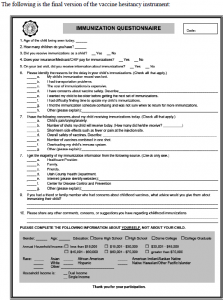Neil Peterson and Dr. Beth Luthy, College of Nursing
The purpose of this project was to develop an instrument to accurately measure vaccine hesitancy in parents of school-aged children. Utah consistently ranks below the national immunization rate average in numerous vaccine categories1. Immunization exemptions in Utah more than doubled between 1997 and 20042. To address vaccine hesitancy, an instrument must be developed to gauge why parents are reluctant to maintain the immunization schedule. The development of this instrument will then be used to understand vaccine hesitancy and steps can be taken to address this growing problem.
Creating the instrument required a combination of searching for similar items used elsewhere in America as well as integrating material that was relevant and important for Utah County, as this is where the future research would take place. Perhaps the greatest barrier to creating the instrument was that little development has been done in this area. I found very few resources that addressed the issue of vaccine hesitancy as well as providing the instrument used to measure it. As a result, the majority of my time was spent in collaborating with the Utah County Health Department (UCHD) and the Utah County Immunization Coalition (UCIC) to develop an instrument that met the needs of the county and would be non-offensive in nature.
After creating a preliminary instrument, I presented it to experts in the field in immunizations as well as UCHD and UCIC. Numerous questions in the instrument were reworded, and some were left out all together. It was felt that the wording needed to be meticulously evaluated for bias and to not be offensive. Also, the goal was to have the entire questionnaire on one side of one paper. This would enhance responses and be less intimidating to fill out.
Unfortunately, not every advice could be implemented, but the final result was acceptable to the experts in the field of immunizations and the finished product can be seen on the next page. The instrument was distributed in the Spring of 2007 and was well responded to. Currently, the results of the survey is being analyzed and being prepared for submission for publication. Additionally, a new website, in conjunction with UCIC and supported by UCHD, has been launched to address further issues about vaccine hesitancy and the results gathered from the use of the instrument. The website is: http://www.immun-wize.org and is preparing for increased advertisement in the Utah County area.
In conclusion, creating an instrument to measure vaccine hesitancy is difficult not only because this area of interest has had little attention, but a consensus is hard to reach regarding the content of the instrument. More research needs to be done in this area, although it is off to a good start.

